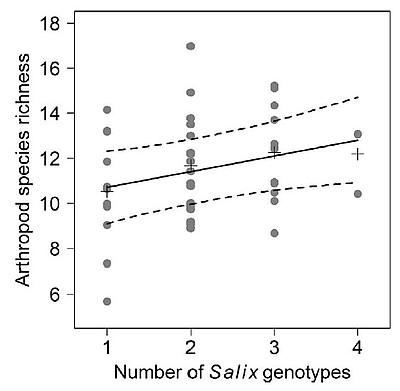Influences of tree diversity on productivity and stability of short rotation coppice plantations

Short Rotation Coppices (SRC) have great potential to contribute to the satisfication of increasing biomass demands due to their rapid growth. For a sustainable biomass production in SRC key aspects like resource use efficiency, maintaining biodiversity and providing multiple ecosystem services must be considered. To date, most existing SRC plantations are willow or poplar monocultures. However, diverse SRC plantations could perform better and render the system more stable by reducing maintenance costs.
This project aimed to investigate the effects of biodiversity on a number of ecosystem processes in SRC plantations. Our study focused on the effect of species and genetic diversity on productivity, wood quality and ecological sustainability.
To this end, two new types of SRC plantations have been planted, either using four Salix varieties (“Tora”, “Jorr”, “Björn”, “Loden”) planted in monocultures and 2, 3 and 4 variety mixtures, or using four tree species (Salix “Tora”, Populus Hybride 275, Paulownia tomentosa, Robinia pseudoacacia), also planted in every combination.
We were able to show that biomass production, as well as wood quality was similar in mixed as in pure stands. The admixture of specific willow varieties increased productivity, while the presence of other rather decreased it. In contrast, the diversity and abundance of insect species increased with an increasing number of willow varieties.
Our results demonstrate that it is possible to design specific mixtures of tree varieties or species that could perform even better than monocultures in terms of biomass production, wood quality and ecological sustainability. The benefits of such “high-diversity SRCs” could grow, the more ecosystem functions and services (i.e. multi-functionality) are taken into account.
| Project title | Biodiversity effect on productivity and stability of short rotation coppice plantations |
| Institution | University of Freiburg, Department of Geobotany in collaboration with Chair of Silviculture, Chair of Nature conservation and landscape ecology, Chair of Hydrology, Chair of Forest Operations
|
| Research group | Prof. Dr. Michael Scherer-Lorenzen, Clara Arranz |
| Project status | Completed |
